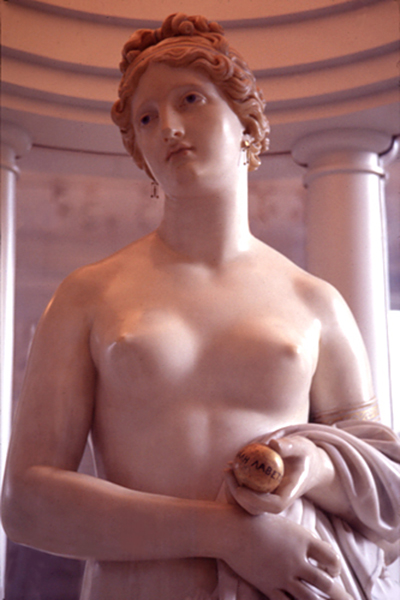"That popular verdict for the so-called 'Tinted Venus' as the most fortunate of our subject's productions is, in our opinion, a just one; the figure is the best of those he made, not only as regards execution, but in being most sincerely conceived. As representing a naked, impudent Englishwoman, it is excellent in its way, but in no respect a Venus, simply because, although almost as meretricious as the 'Venus de Medicis,' there is enough vulgarity in it to destroy all alluring power, and every sign of the goddess....The question of colouring statues, so intimately connected with this figure, has received ample discussion, and may be considered as virtually decided in the affirmative by the practice of the Greeks, at least occasionally, but in a manner that was at once bolder and chaster than that which the circumstances about Gibson permitted him to adopt."
The Athenćum (February 3, 1866)
A member of the Royal Academy, John Gibson was one of the first neoclassical sculptors to color his marble statues. His Venus, which had been shown privately at his studio in Rome, created a sensation when displayed at the London International Exhibition in 1862. Delicately tinted with wax, the goddess holds the golden apple offered to her by Paris. It both entranced and scandalized Victorian society—and suggests the same polychrome realism of the Cnidian Aphrodite.
Gibons's obituary in The Athenćum Journal of Literature, Science, and the Fine Arts (No. 1997) was printed the week after he died. It begins "Possessed of noteworthy accomplishments and much acquired facility, rather than natural power of the first order,—with little insight and less artistic enthusiasm, the place of which, in his mind, was supplied by archćological fervour,—John Gibson was, except Dyce [who decorated Westminster Palace and Queen Victoria's apartment there], the Academician who had the most of education in Art...Had Gibson been endowed with more insight or much enthusiasm, even the narrow conditions under which the Art was accepted while youth remained to him might have admitted a higher aim than to reproduce the antique of a period which was not its best, and a phase of style which was not the most glorious." Damning with faint praise indeed.
Like Pygmalion, Gibson was completely enamored of "my Goddess," which was a replica (or, as he also calls it, a "repetition") of an earlier, uncolored original.
"When this replica for Mr. Preston was finished I took the liberty to decorate it in a fashion unprecedented in modern times. I tinted the flesh like warm ivory—scarcely red—the eyes blue, the hair blond, and the net which contains the hair golden....When all my labour was complete I often sat down quietly and alone before my work, meditating upon it and consulting my own simple feelings. I endeavoured to keep myself free from self-delusion as to the effect of the colouring. I said to myself 'Here is a little nearer approach to life—it is therefore more impressive—yes—yes indeed she seems an ethereal being with her blue eyes fixed on me!' At moments I forgot that I was gazing at my own production; there I sat before her, long and often. How was I ever to part with her!"
And, to be sure, Gibson (who never married) could not bring himself to send the statue away, upon which he had worked intermittently for five years, from 1851 to 1856, until the exasperated Mrs. Preston insisted that the statue be given up—which Gibson finally was obliged to do four years later.
The Tinted Venus now is in the Walker Art Gallery (Liverpool).
Pliny speaks of Nicias "who was an extremely careful painter of female portraits....It is this Nicias of whom Praxiteles used to say, when asked which of his own works in marble he placed highest, 'The ones to which Nicias has set his hand'—so much value did he assign to his colouring of surfaces'" (Natural History, XXXV.xl.130, 133). Although it is not known whether Nicias actually did paint the Cnidia, Pliny's account of a collaboration between the two artists does allow the possibility.
It is likely that the hair was yellow or even gilded, as "golden" is the epithet mostly frequently applied to Aphrodite. Any jewelry, such as an armlet, also would have been in gilt, as may have been the water jar next to her. The eyes, too, would have been colored, as would her cheeks and lips and her discarded gown. Such delicate tinting presumably would have made casts impossible, which may account for such poor copies of the original statue.
The year after Gibson exhibited his Venus, the Augustus of Prima Porta was discovered outside Rome, the imperial statue showing clear traces of polychromy.
References: Homeric Hymns (1914) translated by Hugh G. Evelyn-White (Loeb Classical Library); Lucian: Amores (Vol. VIII) (1967) translated by M. D. MacLeod (Loeb Classical Library); Life of John Gibson, R.A., Sculptor (1870) edited by Lady Eastlake [Elizabeth Rigby]; The Color of Life: Polychromy in Sculpture from Antiquity to the Present (2008) edited by Roberta Panzanelli; The Importance of Colour on Ancient Marble Sculpture (2009) by Mark Bradley.
See also Amazons and Augustus of Prima Porta.
